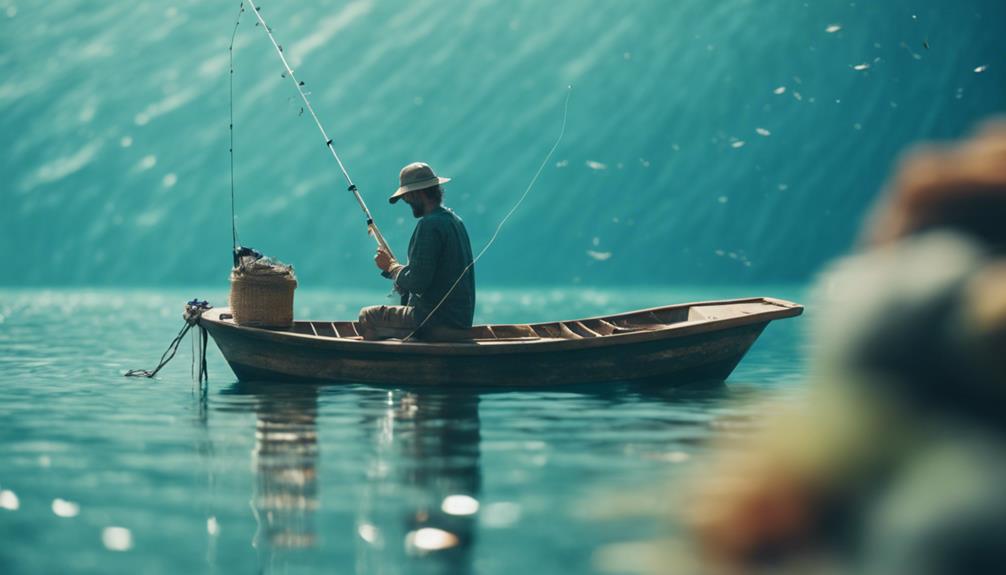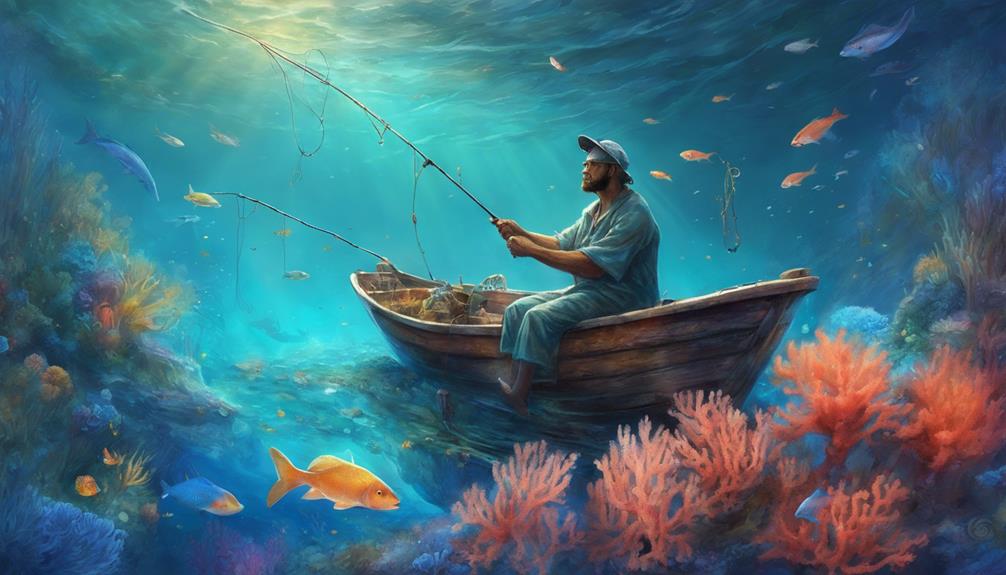When it comes to line fishing, it's like taking a step in the right direction towards preserving our oceans. But have you ever wondered what exactly makes this method eco-friendly?
The answer lies in the way it minimizes harm to marine life and ecosystems. By using biodegradable gear and sustainable practices, line fishing offers a way to enjoy the sport while ensuring the health of our oceans.
But how exactly does this all work? Let's explore the key factors that make line fishing a sustainable choice for anglers.
Key Takeaways
- Line fishing minimizes harm to non-targeted marine life
- Line fishing has lower environmental impact than mass fishing
- Line fishing supports healthy fish populations and ecosystem health
- Line fishing prioritizes sustainable practices and responsible seafood sourcing
Benefits of Hand Line Fishing

Hand line fishing offers numerous advantages for both fishermen and the environment. This method is part of sustainable fishing practices, targeting specific species and minimizing harm to non-targeted marine life. By using a single fishing line with a baited hook, hand line fishing allows for precise control over catches. Fishermen can immediately release any unwanted species back into the ocean, supporting healthy fish populations and maintaining ecosystem balance.
Additionally, hand line fishing is considered eco-friendly due to its minimal equipment requirements, reducing the overall environmental footprint of fishing activities. Choosing hand line fishing not only benefits fishermen by providing a simple and effective fishing technique but also helps protect the marine environment for future generations.
Minimal Impact on Marine Ecosystems

To minimize negative impacts on marine ecosystems, line fishing prioritizes targeted fishing methods and avoids destructive practices such as bottom trawling or dredging.
Here are four key ways line fishing minimizes its impact on marine ecosystems:
- Targeted Fishing: Line fishing focuses on specific fish species, reducing bycatch of non-targeted marine animals.
- Barbless Hooks: The use of barbless hooks allows for the safe release of unintended catches back into the ocean, minimizing harm.
- Reduced Environmental Impact: Line fishing has a lower environmental impact compared to mass fishing techniques like purse seining or trawling.
- Sustainable Practices: Sustainable line fishing methods prioritize the health of marine ecosystems by minimizing disruption and waste.
Sustainable Sourcing of Fish

For sustainable sourcing of fish, prioritize line fishing methods that guarantee minimal impact on marine ecosystems. Line fishing involves capturing one fish at a time using pole and line techniques. This targeted approach helps reduce bycatch, preserving non-targeted marine life and maintaining the balance of marine ecosystems.
By supporting sustainable line fishing practices, you contribute to the reduction of overfishing and promote responsible seafood sourcing. Opting for line fishing methods like pole and line caught tuna guarantees a safer and more sustainable seafood option for consumers.
Choosing responsibly sourced fish benefits coastal fisheries and helps protect the health of our oceans. Make a difference by selecting seafood captured using eco-friendly fishing methods.
Reduced Bycatch and Habitat Damage

Line fishing stands out as an effective method for reducing bycatch and minimizing habitat damage in marine ecosystems. When practicing line fishing, you can benefit from these key aspects:
- By targeting specific fish species, line fishing reduces bycatch and has minimal impact on non-targeted marine life.
- This method helps to minimize habitat damage, unlike more destructive techniques such as trawling or dredging.
- Through the use of barbless hooks and selective targeting, line fishing contributes to preserving the balance of marine habitats.
- Line fishing allows for the release of unintended species back into the ocean, supporting marine biodiversity and promoting sustainable practices.
Preservation of Fish Stocks

Minimizing bycatch and habitat damage, line fishing plays a pivotal role in preserving fish stocks by specifically targeting certain species. This targeted approach helps prevent overfishing in the fishing industry, ensuring the sustainability of fish populations.
By reducing bycatch, line fishing promotes ecosystem health and maintains biodiversity by safeguarding non-targeted species. Sustainable practices like pole and line fishing further enhance the preservation of fish stocks by minimizing environmental impacts on marine habitats.
Additionally, the release of unwanted or undersized fish back into the ocean supports long-term seafood availability. Overall, the selective nature of line fishing contributes to maintaining balanced fish populations, which is essential for the health of our oceans and the long-term viability of the fishing industry.
Conclusion
To sum up, line fishing can be eco-friendly by using biodegradable gear and sustainable methods. By minimizing harm to marine ecosystems, reducing bycatch, and preserving fish stocks, anglers can help support biodiversity and sustainable fisheries.
Choosing hand line fishing over other methods can have a positive impact on the environment and contribute to the health of our oceans. Make a difference by fishing responsibly and protecting our precious marine life.
👨👩👧👦 Dwight’s a married dad of 4 who loves to cast a line 🎣 into both fresh and salt waters. His heart belongs to his family and the sea. 🌊 #FamilyMan #FishingLife #DadOf4 🐟✨

